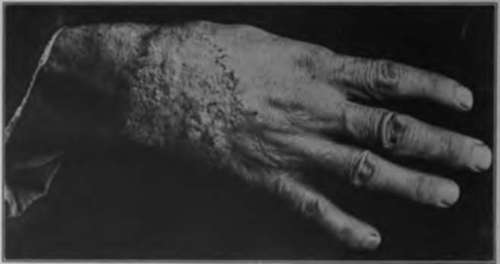4. Scar-Forming Lesions
Description
This section is from the book "Skin Cancer", by Henry H. Hazen, A.B., M.D.. Also available from Amazon: Skin Cancer.
4. Scar-Forming Lesions
As already pointed out, cancer may heal spontaneously in the center, and have only a slight amount of ulceration at the edges: the most extreme example of this type is the morphea-like epithelioma. There are a number of other conditions which likewise cause scarring, perhaps with very little ulceration, and they must be diagnosed from this variety of cancer.
*Stelwagon: Diseases of the Shin, 7th ed., Phila., 1914.
Lupus Vulgaris
Lupus vulgaris will often heal in the center, and show only a comparatively narrow zone of ulceration at the margin. The overhanging edges of skin and the lack of deep induration would serve to distinguish this condition from cancer, even if the ago of the patient did not, for lupus is extremely rare except in childhood.
Syphilis
The lesions of syphilis spread very much more rapidly than do those of superficial cancer, and the ulceration is usually clean and punched out in appearance, besides lacking hardness.

Fig: 68.-Blastomycosis. (Author's collection).
Lupus Erythematosus
Lupus erythematosus causes scarring without ulceration; the surface of the skin is covered by closely adherent white scales, and the follicles gape widely; the color is pink ish. The lesions are usually multiple, have a great tendency to be symmetrical upon the face, especially the nose, cheeks, and arounc the ears. This condition may be confused with syphilis, but not of cancer.
Morphea
Morphea may simulate one type of cancer, already fully described under the heading of morphca-like epithelioma in the chapter on the basal-celled cancers. As pointed out at that time, the presence of ulceration or of a raised firm edge should suffice to differentiate between them. Rarely the cancer en cuirasse may resemble a scleroderma, but examination of the breast will usually clear up .the diagnosis.
Serodiagnostic Methods
It is impossible to conclude a chapter on the diagnosis of cancer without a word or two of reference to the attempts at laboratory diagnosis by means of utilizing the changes in the bodily cells and fluids that have taken place because of cancer. The majority of these tests are satisfactorily described in the third edition of Muller's "Serodiagnostic Methods," translated by Whitman*.
The reaction of Freund and Kaminer* depends on the observation that the blood serum of normal individuals has the power to dissolve cancer cells, the serum of cancer patients lacking this power -indeed having the power to inhibit the destruction of such cells by normal serum.
Von Dungern* has attempted the diagnosis by the well-known principle of deviation of the complement, but in the hands of others the results have not been satisfactory.
Kraus, Graff, and Eanzi* have attempted to diagnose cancer by means of the cobra venom method, which depends on the principle that in certain conditions human blood serum possesses the ability to activate the hemolysis of horse's red blood cells by cobra venom.
Marcus's* modification of the method of Miiller and Jochmann* depends on the fact that the digestive power of trypsin is neutralized by a certain amount of serum or blood. The method of Berg-^mann and Meyer* depends on the same principle.
The meiostagmin reaction, as practiced by Ascoli and Izar* and others depends on the principle that, when diluted blood serum of patients is mixed with a homologous antigen and heated, there occurs a specific lowering of the surface tension.
Elsberg, Neuhof, and Geist* have described a skin reaction for carcinoma that has been investigated in this country by Lisser and Bloomfield* at the Johns Hopkins Hospital. The injection of 5 minims of a 20 percent suspension of washed human red blood cells just beneath the skin is followed by a characteristic reaction in many cancer patients.
*Mtiller: Serodiagnostic Methods, 3d ed. (translated by Whitman), Phila., 1913. 5 Freund and Kaminer: Wien. klin. Wchnschr., 1911, xxiv, 1759. •Von Dungern: Mtinch. med. Wchnschr., 1912, lix, 65, 1098, 2854. 7 Kraus, Graff, and Ranzi: Wien. klin. Wchnschr., 1911, No. 28. "Marcus: Berl. klin. Wchnschr., 1909, No. 4.
*Miiller and Jochmann: Munch, med. Wchnschr., 1909, Nos. 29, 31.
*Bergmann and Meyer: Berl. klin. Wchnschr., 1908, No. 37.
*Ascoli and Izar: Munch, med. Wchnschr., 1910, lvii, 62, 182, 392, 403, 842, 1170, 2129.
*Elsberg, Neuhof, and Geist: Amer. Jour. Med. Sc., 1910.
*Lisser and Bloomfleld: Bull. Johns Hopkins Hospital, 1912, xxiii, 356.
Even more recently it has been proposed to use a modification of the Abderhalden reaction for pregnancy.14
Fortunately, however, in cancer of the skin it is not necessary to depend on such methods, for the diagnosis can usually be made by inspection, and, if not, by the examination of tissue, which is always readily obtained.
Continue to:
Tags
bookdome.com, books, online, free, old, antique, new, read, browse, download
